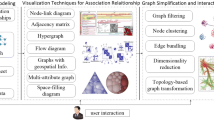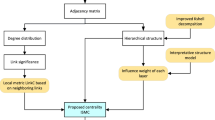Abstract
k-core is important in many graph mining applications, such as community detection and clique finding. As one generalized concept of k-core, (i, j)-core is more suited for bipartite graph analysis since it can identify the functions of two different types of vertices. Because (i, j)-cores evolve as edges are inserted into (removed from) a dynamic bipartite graph, it is more economical to maintain them rather than decompose the graph recursively when only a few edges change. Moreover, many applications (e.g., graph visualization) only focus on some dense (i, j)-cores. Existing solutions are simply insufficiently adaptable. They must maintain all (i, j)-cores rather than just a subset of them, which requires more effort. To solve this issue, we propose novel maintenance methods for updating expected (i, j)-cores. To estimate the influence scope of inserted (removed) edges, we first construct quasi-(i, j)-cores, which loosen the constraint of (i, j)-cores but have similar properties. Second, we present a bottom-up approach for efficiently maintaining all (i, j)-cores, from sparse to dense. Thirdly, because certain applications only focus on dense (i, j)-cores of top-n layers, we also propose a top-down approach to maintain (i, j)-cores from dense to sparse. Finally, we conduct extensive experiments to validate the efficiency of proposed approaches. Experimental results show that our maintenance solutions outperform existing approaches by one order of magnitude.





Similar content being viewed by others
References
Ahmed A, Batagelj V, Fu X, Hong SH, Merrick D, Mrvar A (2007) Visualisation and analysis of the internet movie database. In: International Asia-Pacific symposium on visualization, pp 17–24
Akkoyunlu EA (1973) The enumeration of maximal cliques of large graphs. SIAM J Comput 2(1):1–6
Bai W, Chen Y, Wu D (2020) Efficient temporal core maintenance of massive graphs. Inf Sci 513:324–340
Berlowitz D, Cohen S, Kimelfeld B (2015) Efficient enumeration of maximal k-plexes. In: ACM SIGMOD international conference on management of data, pp 431–444
Bonchi F, Gullo F, Kaltenbrunner A, Volkovich Y (2014) Core decomposition of uncertain graphs. In: ACM SIGKDD international conference on knowledge discovery and data mining, pp 1316–1325
Cheng J, Ke Y, Chu S, Ozsu MT (2011) Efficient core decomposition in massive networks. In: IEEE international conference on data engineering, pp 51–62
Cheng Y, Lu C, Wang N (2013) Local k-core clustering for gene networks. In: IEEE international conference on bioinformatics and biomedicine, pp 9–15
Ding D, Li H, Huang Z, Mamoulis N (2017) Efficient fault-tolerant group recommendation using alpha-beta-core. In: ACM international conference on information and knowledge management, pp 2047–2050
Giatsidis C, Thilikos DM, Vazirgiannis M (2012) D-cores: measuring collaboration of directed graphs based on degeneracy. In: IEEE international conference on data mining, pp 311–343
He X, Gao M, Kan MY, Wang D (2017) Birank: towards ranking on bipartite graphs. IEEE Trans Knowl Data Eng 29(1):57–71
Huang X, Cheng H, Qin L, Tian W, Yu JX (2014) Querying k-truss community in large and dynamic graphs. In: ACM SIGMOD international conference on management of data, pp 1311–1322
Jiang H, Li CM, Manya F (2017) An exact algorithm for the maximum weight clique problem in large graphs. In: Proceedings of the AAAI conference on artificial intelligence, pp 830–838
Khaouid W, Barsky M, Srinivasan V, Thomo A (2015) k-core decomposition of large networks on a single pc. Proc VLDB Endow 9(1):13–23
Li RH, Yu JX, Mao R (2014) Efficient core maintenance in large dynamic graphs. IEEE Trans Knowl Data Eng 26(10):2453–2465
Liu B, Yuan L, Lin X, Qin L, Zhang W, Zhou J (2020) Efficient (\(\alpha \), \(\beta \))-core computation in bipartite graphs. VLDB J 29(5):1075–1099
Lu C, Yu JX, Wei H, Zhang Y (2017) Finding the maximum clique in massive graphs. Proc VLDB Endow 10(11):1538–1549
Montresor A, De Pellegrini F, Miorandi D (2011) Distributed k-core decomposition. IEEE Trans Parallel Distrib Syst 24(2):288–300
Mukherjee AP, Tirthapura S (2017) Enumerating maximal bicliques from a large graph using mapreduce. IEEE Trans Serv Comput 10(5):771–784
Saríyüce AE, Gedik B, Jacques-Silva G, Wu KL, Çatalyürek ÜV (2013) Streaming algorithms for k-core decomposition. Proc VLDB Endow 6(6):433–444
Semertzidis K, Pitoura E, Terzi E, Tsaparas P (2019) Finding lasting dense subgraphs. Data Min Knowl Discov 33(5):1417–1445
Wang X, Liu J (2018) A comparative study of the measures for evaluating community structure in bipartite networks. Inf Sci 448:249–262
Wang Y, Cai S, Yin M (2018) New heuristic approaches for maximum balanced biclique problem. Inf Sci 432:362–375
Wen D, Qin L, Zhang Y, Lin X, Yu JX (2016) I/o efficient core graph decomposition at web scale. In: IEEE international conference on data engineering, pp 133–144
Wen D, Qin L, Zhang Y, Lin X, Yu JX (2019) I/o efficient core graph decomposition: application to degeneracy ordering. IEEE Trans Knowl Data Eng 31(1):75–90
Wu H, Cheng J, Huang S, Ke Y, Lu Y, Xu Y (2014) Path problems in temporal graphs. Proc VLDB Endow 7(9):721–732
Wu H, Cheng J, Lu Y, and Ke Y (2015) Core decomposition in large temporal graphs. In: IEEE international conference on big data, pp 649–658
Yang Y, Yan D, Wu H, Cheng J, Zhou S, Lui J (2016) Diversified temporal subgraph pattern mining. In: ACM SIGKDD international conference on knowledge discovery and data mining, pp 1965–1974
Zhang Y, Yu JX, Zhang Y, Qin L (2017) A fast order-based approach for core maintenance. In: International conference on data engineering, pp 337–348
Zou Z (2016) Bitruss decomposition of bipartite graphs. In: International conference on database systems for advanced applications, pp 218–233
Acknowledgements
This work was supported by the National Key R&D Program of China under Grant 2018YFB0204100, the National Natural Science Foundation of China under Grants 61572538, 61802451, and U1911201, Guangdong Special Support Program under Grant 2017TX04X148. Di Wu is the corresponding author.
Author information
Authors and Affiliations
Corresponding author
Additional information
Responsible editor: M. J. Zaki.
Publisher's Note
Springer Nature remains neutral with regard to jurisdictional claims in published maps and institutional affiliations.
Appendix A Proofs and Algorithms
Appendix A Proofs and Algorithms
Proof for Lemma 1
Let \(C = C(G_p,i,j)\) and \(P = P(i,j)\), \({\hat{C}}(P,C,i,j) \subseteq P\) holds by Definition 4. Thus, we just prove \(P \subseteq {\hat{C}}(P,C,i,j)\). Suppose there is a nonempty graph \(A = P \setminus {\hat{C}}(P,C,i,j)\), there must be a vertex \(l\ (r) \in A\) such that \(d(P(C),l)<i\ (d(P(C),r)<j)\), where P(C) is the extended graph of A on C, and this vertex leads to the recursive deletion on P. Otherwise, \({\hat{C}}(P,C,i,j)\) can expand via \(l\ (r)\). Since \(P = C(G_c,i,j) \setminus C\), \(d(P(C),l) \ge i\ (d(P(C),r) \ge j)\) always holds for \(l\ (r) \in P\), which makes a contradiction. Thus, \(P \subseteq {\hat{C}}(P,C,i,j)\).
In summary, \(P = {\hat{C}}(P,C,i,j)\). \(\square \)
Proof for Theorem 1
Let \(C = C(G_p,i,j)\), \(F = F_b(i,j)\) and \(P = P(i,j)\). Firstly, we prove \({\hat{C}}(F,C,i,j) \subseteq P\). Suppose there is a nonempty graph \(A = {\hat{C}}(F,C,i,j) \setminus P\), there must be a vertex \(l\ (r) \in A\) such that \(d(F(C),l)<i\ \) \((d(F(C),r)<j)\) and this vertex leads to recursive deletion on A, where F(C) is the extended graph of F on C. Otherwise, P can expand via \(l\ (r)\), which contradicts Definition 6. According to Definition 5, \(d(F(C),l) \ge i\ \) \((d(F(C),r) \ge j)\) holds for an arbitrary \(l\ (r) \in F\) unless there is a vertex \(l'\ (r') \in C\) such that \(d(C,l')< i\ (d(C,r') <j)\). Since C is the previous (i, j)-core, this makes a contradiction. As for an edge \((l,r) \in A\), since \(l,r \in P\), P can expand via adding (l, r), which contradicts Definition 6. Thus, \({\hat{C}}(F,C,i,j) \subseteq P\).
Secondly, we prove \(P \subseteq {\hat{C}}(F,C,i,j)\). Since \(P\subseteq F\), \({\hat{C}}(P,C,i,j) \subseteq {\hat{C}}(F,C,i,\) j) holds. By Lemma 1, \(P(i,j) = {\hat{C}}(P,C,i,j) \subseteq {\hat{C}}(F,C,i,j)\).
In summary, \(P = {\hat{C}}(P,F,i,j)\). \(\square \)
Proof for Theorem 2
Since \(C(G_p,i,j)=\emptyset \), we have \(C(G_c,i,j) = P(i,j) \subseteq F_b(i,j)\). Since \(F_b(i,j) \subseteq G_{c}\), \(C(F_b(i,j),i,j) \subseteq C(G_c,i,j)\) holds. Due to \(C(G_c,i,j) \subseteq F_b(i,j)\), we have \(C(G_c,i,j) \subseteq C(F_b(i,j),i,j)\).
In summary, \(C(F_b(i,j),i,j)=C(G_c,i,j) = P(i,j)\). \(\square \)
Proof for Theorem 3
Let \(F = F_t(i,j) \), \(P = P(i,j)\) and \(C = C(G_c,i+1,j) \cup C(G_c,i,j+1) \cup C(G_p,i,j)\). Firstly, we prove \(({\hat{C}}(F,C,i,j) \cup C(G_c,i+1,j) \cup C(G_c,i,j+1)) \setminus C(G_p,i,j) \subseteq P\). Since \( C(G_c,i+1,j) \cup C(G_c,i,j+1) \subseteq C(G_c,i,j)\), \((C(G_c,i+1,j) \cup C(G_c,i,j+1)) \setminus C(G_p,i,j) \subseteq P\) holds. Since \({\hat{C}}(F,C,i,j) \setminus C(G_p,i,j) = \emptyset \), we just need to prove \({\hat{C}}(F,C,i,j) \subseteq P\). Suppose there is a nonempty graph \(A ={\hat{C}}(F,C,i,j)\setminus P\), we have \(d(F(C), l) \ge i\) or \(d(F(C),r) \ge j\) for arbitrary \(l,r \in A\), where F(C) is the extended graph of F on C. If \(l \notin P\), there must be a vertex \(l' \in C \ (r' \in C)\) such that \(d(C,l')<i\ (d(C, r') < j)\), which makes a contradiction. Since \(l,r \in P\), if \((l,r) \notin P\), then we have \(P \subseteq P \cup (l,r)\), which contradicts Definition 6. Thus, \(({\hat{C}}(F,C,i,j) \cup C(G_c,i+1,j) \cup C(G_c,i,j+1) ) \setminus C(G_p,i,j) \subseteq P\).
Secondly, we prove \( P \subseteq ({\hat{C}}(F,C,i,j) \cup C(G_c,i+1,j) \cup C(G_c,i,j+1)) \setminus C(G_p,i,j)\). Suppose there is a nonempty graph \(A = P \setminus (({\hat{C}}(F,C,i,j) \cup C(G_c,i+1,j) \cup C(G_c,i,j+1)) \setminus C(G_p,i,j))\). Since \((C(G_c,i+1,j) \cup C(G_c,i,j+1)) \setminus C(G_p,i,j) \subseteq P\) and \({\hat{C}}(F,C,i,j) \setminus C(G_p,i,j) = {\hat{C}}(F,C,i,j)\), \( A \subseteq P \setminus {\hat{C}}(F,C,i,j)\) holds. Clearly, \(A \subseteq F\). Since \(A \ne \emptyset \), there must be a vertex \(l\ (r) \in A\) such that \(d(F(C),l)<i\ (d(F(C),r)<j)\), where F(C) is the extended graph of F on C. By Definition 7 and C is the union graph of previous (i, j)-core, \((i+1,j)\)-core and \((i,j+1)\)-core, \(d(F(C),l) \ge i\ (F(C),r) \ge j)\) holds for \(l\ (r) \in A\). Again, this is contradiction. Hence, \( P \subseteq ({\hat{C}}(F,C,i,j) \cup C(G_c,i+1,j) \cup C(G_c,i,j+1)) \setminus C(G_p,i,j)\).
In summary, \( P = ({\hat{C}}(F,C,i,j) \cup C(G_c,i+1,j) \cup C(G_c,i,j+1)) \setminus C(G_p,i,j)\). \(\square \)
Proof for Theorem 4
Let \(F = F_t(i,j)\), \(P = P(i,j)\) and \(C = C(G_c,i+1,j) \cup C(G_c,i,j+1)\). Firstly, we prove \({\hat{C}}(F,C,i,j) \cup C \subseteq P\). Since \(C(G_p,i,j) = \emptyset \), we have \(P= C(G_c,i,j)\). By Definition 6, we have \(C \subseteq C(G_c,i,j) = P\). Thus, we just need to prove \({\hat{C}}(F,C,i,j) \subseteq P\). Suppose there is a nonempty graph \(A = {\hat{C}}(F,C,i,j)\setminus P\), we have \(d(F(C),l) \ge i\ (d(F(C), r) \ge j)\) for arbitrary \(l \in A\ (r \in F)\), where F(C) is the extended graph of F on C. If \(l \notin P\), there must be a vertex \(l' \in C\ (r' \in C)\) such that \(d(C,l')< i\ (d(C,r') < j)\), which makes a contradiction because C is the union graph of \((i+1,j)\)-core and \((i,j+1)\)-core. Since \(l,r \in P\), if \((l,r) \notin P\), then we have \(P \subseteq P \cup (l,r)\), which contradicts Definition 6. Thus, \({\hat{C}}(F,C,i,j) \cup C \subseteq P\).
Secondly, we prove \(P\subseteq {\hat{C}}(F,C,i,j) \cup C\). Suppose there is a nonempty graph \(A = P \setminus ({\hat{C}}(F,C,i,j) \cup C)\), since \(C \subseteq P\), we have \(A \subseteq P \setminus {\hat{C}}(F,C,i,j)\). Clearly, \(A \subseteq F\), otherwise it contradicts our assumption. Since \(A \ne \emptyset \), there must be a vertex \(l\ (r) \in A\) such that \(d(F(C),l)<i\ (d(F(C),r)<j)\), where F(C) is the extended graph of F on C. By Definition 7 and C is the union graph of \((i+1,j)\)-core and \((i,j+1)\)-core, \(d(F(C),l) \ge i\ (d(F(C),r) \ge j)\) holds for \(l\ (r) \in A\). Again, this is a contradiction. Hence, \( P \subseteq {\hat{C}}(F,C,i,j) \cup C\).
In summary, \(P = {\hat{C}}(F,C,i,j) \cup C\). \(\square \)



Rights and permissions
About this article
Cite this article
Bai, W., Chen, Y., Wu, D. et al. Generalized core maintenance of dynamic bipartite graphs. Data Min Knowl Disc 36, 209–239 (2022). https://doi.org/10.1007/s10618-021-00805-0
Received:
Accepted:
Published:
Issue Date:
DOI: https://doi.org/10.1007/s10618-021-00805-0




